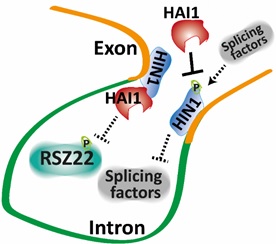[Paul Verslues] Highly ABA-Induced 1 (HAI1)-Interacting protein HIN1 and drought acclimation-enhanced splicing efficiency at intron retention sites
POST:The ability of plants to acclimate and maintain productivity under changing environmental conditions is important because of climate change and increasing demands on agriculture. Plant acclimation to abiotic stresses such as drought involves multiple layers of gene regulation and post-translational protein modifications. Pre-mRNA splicing, particularly intron retention (IR), is altered by stress yet little is known about how stress signaling impinges upon the splicing machinery to cause such changes. In previous research, the Verslues laboratory noted that the protein phosphatase Highly ABA-Induced 1 (HAI1) has especially prominent effects on drought phenotypes such as growth and proline accumulation. A screen for HAI1 interacting proteins identified a protein of unknown function, HAI1 Interacting Protein 1 (HIN1) (Chong et al., 2019 PNAS). HIN1 is a new type of plant-specific RNA-binding protein that affects splicing efficiency of IR-prone introns. HIN1 is involved in enhanced splicing efficiency of IR-prone introns that occurs during drought acclimation and interacts with several splicing regulators. HIN1 can be dephosphorylated by HAI1 and may also recruit HAI1 to dephosphorylate other splicing regulators. This later hypothesis is consistent with our previous phosphoproteomics analysis (Wong et al., 2019 PNAS) which identified splicing factors and RNA binding proteins as putative targets of HAI1-regulated dephosphorylation. Together these data show that HAI1-HIN1 regulation is a new mechanism connecting stress signaling to pre-mRNA splicing.
